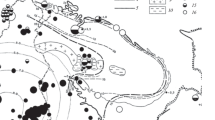Abstract
Raoul Island, the largest of the Kermadec Group, is about 8 km across and is situated about 1100 km north-east of Auckland, New Zealand. An eruption of steam and mud occurred on the island on 1964 November 21 (local date); this was preceded by an earthquake swarm which started on 10 November. Records made with the Willmore seismograph at the Meteorological Station on the north coast of the island show that within four hours of the start of the swarm, the frequency of shocks had risen to a peak of more than 80 an hour. Most shocks had sharp beginnings with S-P intervals of 1 to 2 seconds. Tremor was noticeable on 11 November and increased until by 12 November it was continuous, masking all but the largest of the discrete shocks. The level of tremor and the number of recorded shocks then decreased, until by the time the largest earthquake occurred on November 14, only 30 to 40 shocks were being recorded per hour. The largest earthquake was assigned a magnitude of 5.7 from recordings made in New Zealand, and was felt on Raoul Island at intensity 7 on the Modified Mercalli scale.
Further shocks and tremor were recorded, and on 15 November the tremor was particularly active for several hours. On 21 November, an eruption occurred, throwing steam, mud, and rocks to an estimated height of 800 m from a crater on the edge of Green Lake, about 2 km from the Meteorological Station. During the eruption the seismograph recorded a peak vibration 30 to 40 times the amplitude of the normal background level. By two hours after the eruption, the level of vibration had stabilised at double that before the eruption.
The island was evacuated from 23 November until 6 December, during which time the seismograph was inoperative. From 6 December to 11 December three portable seismographs were recording in addition to the permanent station. By this time the frequency of recorded shocks had dropped to about two per hour. The earthquakes were located in the vicinity of Denham Bay, some kilometres to the west of the main crater. Volcanic activity has been observed previously in Denham Bay, and it is thought that the Bay may be a former crater.
Similar content being viewed by others
Author information
Authors and Affiliations
Additional information
Paper read at the IAV International Symposium on Volcanology, New Zealand, scientific session of Nov. 23, 1965.
Rights and permissions
About this article
Cite this article
Adams, R.D., Dibble, R.R. Seismological studies of the Raoul Island eruption, 1964. Bull Volcanol 29, 3–6 (1966). https://doi.org/10.1007/BF02597135
Issue Date:
DOI: https://doi.org/10.1007/BF02597135




